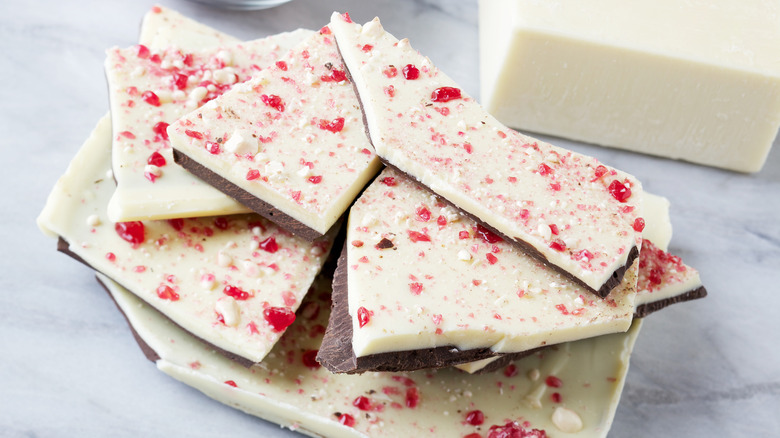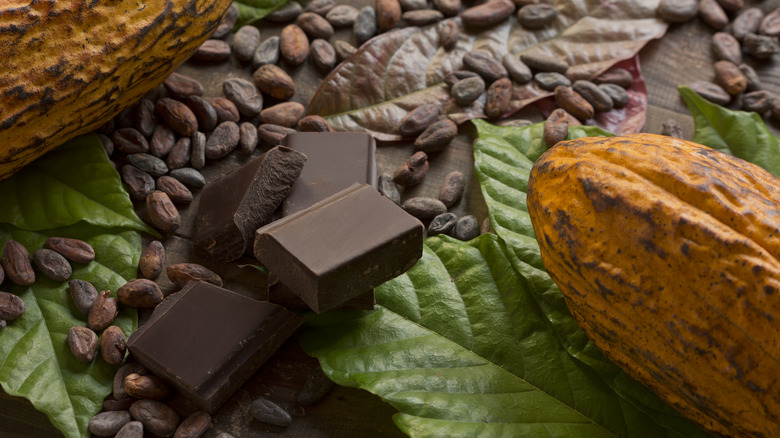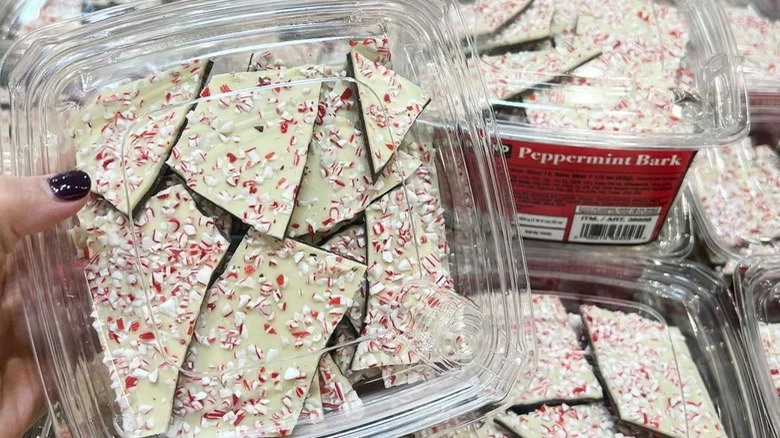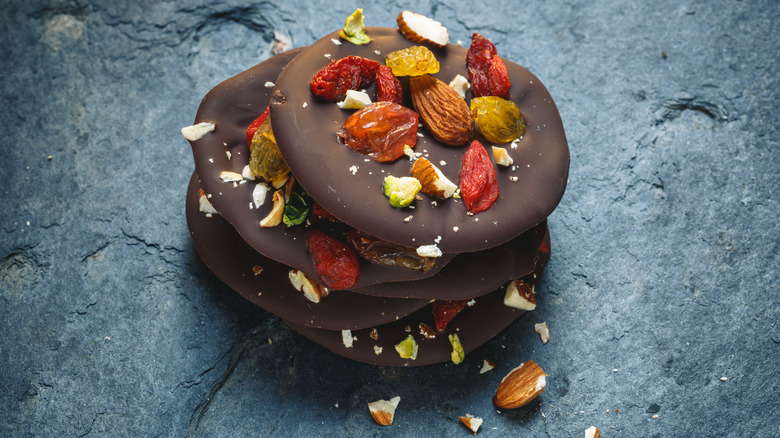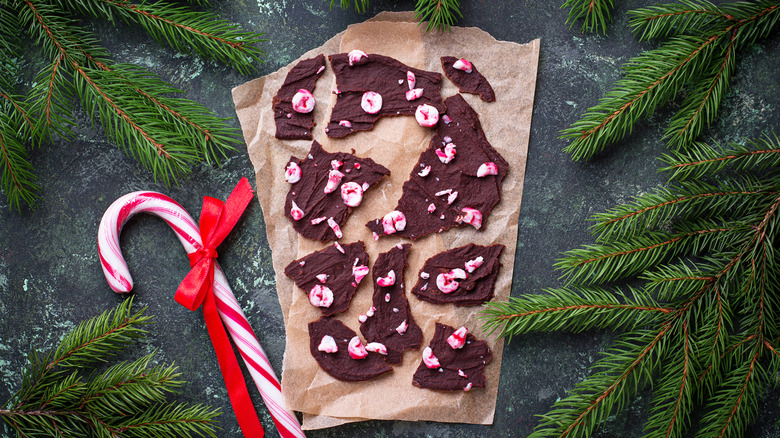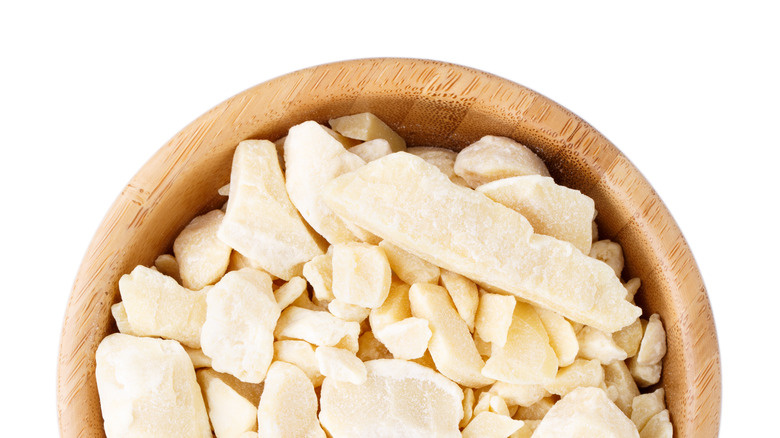Everything You Need To Know About Peppermint Bark
What pumpkin spice is to fall, peppermint bark must be to winter. This festive treat sees melted white and dark chocolate infused with peppermint extract and layered together before being sprinkled with crushed mint candies. Broken into shards, the confection is easy to share out and positively perfect for the holidays.
But did you know that peppermint bark was only popularized beginning in the late 1990s? Or that we have one of America's most popular kitchen supply stores to thank? How about that peppermint bark has since spawned a host of varieties and flavors and inspired countless baked goods? Best of all, if you don't want to shell out money for the real deal, it's super simple to make at home, like this recipe for three-ingredient peppermint bark.
If you want to learn everything there is to know about peppermint bark, you've come to the right place. As the company behind the candy's renown celebrates the 25th anniversary of its recipe for Original Peppermint Bar in 2023, we decided a closer look would be in order. So pull up a chair, and grab a bit of bark. It's time to indulge in some candy trivia!
Peppermint bark was popularized by Williams Sonoma in 1998 – and it's been a hit ever since
There's evidence that peppermint bark has been around since at least 1966 (if not earlier), but if it's become such a household staple at during the holidays, we have Chuck Williams of Williams Sonoma to thank. The company founder was ostensibly a lover of retro candies. In 1998, he challenged his team to come up with confections inspired by the past. The results included a creation layering white chocolate over dark and scattering the top with crunchy bits of peppermint candy.
Peppermint bark became a runaway hit for Williams Sonoma, selling out its first year and earning a starring role the next season on the cover of the kitchenware shop's holiday catalog. This was a rare honor for a food item, Amanda Haas, the former culinary director for Williams Sonoma, told Delish.
These days, peppermint bark is so beloved that many consumers seek it out as early as October, but due to temperature concerns, the brand just can't get it out any earlier than that. In fact, all of the peppermint bark for the brand's seasonal demands is manufactured in just 12 weeks. Despite the seasonal availability of the candy, Williams Sonoma goes through a million pounds of chocolate and 65,000 pounds of peppermint bits each year to make it. If that's not a sign that Williams has a real hit, we're not sure what is.
Williams Sonoma uses only the best ingredients
It took 20 rounds of recipe testing for the team at Williams Sonoma to perfect the recipe for peppermint bark as they sought the ideal balance of sweetness and minty freshness. The company starts with chocolate from Guittard, an artisan, family-owned chocolatier based for over 150 years in Northern California. Guittard also supplies the chocolate for other beloved American sweet treats, such as San Francisco's See's Candies.
To make Williams Sonoma's peppermint bark, Guittard has crafted two proprietary chocolate blends — one dark, one white. The dark chocolate has a bit more bitterness than one might expect from a dark chocolate, with a goal of offsetting the sweetness of the white. The third ingredient is essential — essential oil, to be exact. A triple-distilled peppermint oil brings loads of pure peppermint flavor to the table, and it's perhaps what renders the Williams Sonoma iteration of this candy so inimitable. For the perfect finishing touch, a topping of crushed peppermint candies gives the bark the crunch that candy lovers look for.
Costco sells a cheaper version of peppermint bark
Williams Sonoma's peppermint bark is exceptional — and it's evident in the price people are willing to pay for it. A 16-ounce tin of the coveted confection retails for nearly $30. That said, this isn't the only place you can get your hands on peppermint bark. There are other retailers that make their own answer to the original, and often they sell at a far lower price point.
Costco, for example, sells a 21-ounce container of Kirkland Signature bark for $9.99 — a steal as compared to the real thing from Williams Sonoma. The big box store's version is made with Belgian dark and white chocolate. The treat is tasty, though it is fairly mild in peppermint zing, according to one shopper reviewing the product. (Guess Costco isn't springing for that triple-distilled essential oil.)
Not one to be outdone, Ghirardelli also sells its own version of peppermint bark, albeit produced in easy-to-eat squares. Retailing for $21.60 per pound, it's a tasty, slightly cheaper alternative to the Williams Sonoma version, but it lacks the jagged, broken bark appeal of the original and doesn't have nearly as much crunch.
It may have roots in a traditional French Christmas candy
Peppermint bark may well have its roots in a classic French Christmas confection, albeit one completely devoid of peppermint. Mendiants are chocolate slabs or coins studded with all sorts of ingredients typical of the 13 desserts tradition popular in the area around Provence of France. (Yes, you read that right!) But don't go thinking the French have gone a bit overboard when it comes to Yuletide desserts. In Provence, most of the 13 desserts are actually fruits or nuts as well as a few local confections like calissons or nougat, and a sort of olive oil-based brioche dubbed pompe à l'huile.
How is this all related to chocolate? Four of the ingredients allude to the four major mendicant orders of Catholic monks: almonds for the Carmelites, walnuts or hazelnuts for the Augustines, figs for the Franciscans, and raisins for the Dominicans. The word "mendiant," which in French means beggar, is a reference to these items, which are frequently scattered atop the chocolate.
While the use of peppermint in place of almonds and raisins gives the Williams Sonoma candy a more Christmassy vibe for Americans, the technique is nevertheless quite similar — and the result is delicious no matter how you slice it.
It can be eaten as-is or melted into hot chocolate
While it's easy to plow through a whole tin of peppermint bark on its own, some folks get pretty creative when they're digging into their peppermint bark, choosing to use it as an ingredient for something else. A survey of 2,000 people through National Today and publicized in honor of National Peppermint Bark Day on December 1, 2023, shows that while 33% of peppermint bark fans choose to eat it as-is, a whopping 23% melt it into hot chocolate for a minty cup of cocoa.
Gourmet gift company Harry & David, which also make a version of peppermint bark (this one retailing at $39.99 per pound and thus coming in even pricier than the Williams Sonoma version) offers a recipe for homemade peppermint bark hot chocolate that sees the candy melted into a combo of baking cocoa, sugar, water, milk, peppermint and vanilla extracts, and a pinch of salt. Other recipes are way simpler, relying on a simple combo of store-bought cocoa mix and peppermint bark. Either way, consider garnishing your toasty, chocolatey beverage with a candy cane for even more fresh minty flavor.
Peppermint bark is easy to make at home
If forking out a lot of money for peppermint bark doesn't sound like your cup of tea, there's good news: It's really easy to make your own homemade peppermint bark. You just need four ingredients — white chocolate, dark chocolate, peppermint extract, and your choice of peppermint candy — and you're nearly there.
First, you'll crush the peppermints with a rolling pin (this is a great job for kids who want to help). Next, you'll melt the chocolate in the microwave with the peppermint extract until smooth. The chocolate is layered on a baking sheet before being topped with the candies. This candy needs to set for 20 minutes in the fridge. Then it's time to break this bark and share it out. The only technical part of the recipe is chilling the bottom layer just enough so that the white chocolate doesn't swirl into the dark, but not so much that it's completely hardened and cooled; this could lead your bark to separate when you break it. Letting it come to room temperature before breaking it into pieces can also help.
When you're making peppermint bark at home, feel free to change things up. Consider using sweeter milk chocolate instead of dark, or do layers of milk and dark chocolate, leaving out the white. You could also swirl the chocolate together instead of layering it, which does away with any concerns over separating. It also has a gorgeous effect on the finished treat.
Peppermint bark has a pretty long shelf life, provided you store it properly
Unlike many other Christmas confections like cookies or gingerbread, peppermint bark actually has a pretty long shelf life. Most store-bought peppermint bark will last a year or more — even when it doesn't contain any preservatives — so you can enjoy it long after the other Christmas treats have disappeared.
When it comes to homemade peppermint bark, you should take a few precautions to ensure it lasts as long as possible. Wrapping the candy in wax paper followed by plastic wrap will prevent oxygen from coming into contact with the chocolate, causing it to oxidize. Once it's wrapped, homemade peppermint bark can easily be kept in the fridge for up to two weeks or frozen for up to six months ... if it lasts that long in your home! Just be sure to bring it up to room temperature before eating so that you get the best flavor.
There are loads of varieties of peppermint bark
While the classic peppermint bark couldn't be simpler, there are actually lots of different varieties on the market. Milk chocolate peppermint bark is a common variant for those who prefer the treat a bit on the sweeter side, while Godiva makes a peppermint bark that's much heavier on the dark chocolate for more of a bitter edge that marries wonderfully with the fresh taste of peppermint.
Over the years, Williams Sonoma has added to its array of peppermint bark goodies. This year, the retailer offers a grand total of 35 different peppermint bark products, including a dark chocolate version and an iteration sprinkled with Jacobsen sea salt, harvested in Oregon, for what the brand dubs a more "sophisticated" vibe. Williams Sonoma has also crafted a few peppermint bark derivative products, like paw-shaped bark, a nod to the brand's Dalmatian mascot (and perhaps an evocation of the homophone for bark) and peppermint bark pretzels, which are a bit less sweet than the classic candy on its own. Of course, its original recipe is always available during the holiday season.
"We are proud to be the originators of the Peppermint Bark trend, having developed a flavor profile that has become as synonymous with the holidays as pumpkin spice is to fall," Williams Sonoma President Felix Carbullido said in a 2023 press release.
Peppermint bark can be made sugar-free for keto dieters
If you or someone in your family is on a keto diet but don't want to miss out on the festivity of peppermint bark, there's good news: You don't have to! Peppermint bark can easily be made keto-friendly by opting for sugar-free chocolate chips and sugar-free candy canes.
Of course, keto peppermint bark does present a few unique challenges. Since sugar-free chocolate doesn't melt quite as easily as the regular stuff, you may want to add a bit of cocoa butter to help make it smooth. And as sugar-free white chocolate can be difficult to find, you may prefer to make your own using allulose, coconut milk powder, cocoa butter, and coconut oil. It's a bit more effort than making traditional peppermint bark, but it's definitely a labor of love that you or your loved ones on a low-sugar diet will appreciate.
Peppermint bark has inspired loads of other recipes and products
From its humble beginnings as an old-timey candy, peppermint bark has found its way into loads of other products. Williams Sonoma has transformed peppermint bark into dozens of treats, including cookies with a chocolate wafer core coated in peppermint-infused white chocolate and dusted in crunchy peppermint candy. The brand has also used the recipe to craft brownies that see these favorite gooey chocolate bars topped with peppermint creme and chocolate ganache that is studded with peppermint candy bits. You can even score peppermint bark coffee capsules, peppermint bark butter, and a peppermint bark ice cream cake from the retailer. Are you a fan of caramel apples? Why not try peppermint bark apples from Williams Sonoma instead?
And that's only the beginning! Aldi has a seasonal peppermint bark creamer, and Trader Joe's makes a peppermint bark version of its Joe-Joe's. Häagen-Dazs sells a limited edition peppermint bark ice cream with a white chocolate base and chunks of chocolate peppermint bark and peppermint candy pieces. Recipe developers have also come up with their own spins on peppermint bark. Motivated home cooks can try their hands at a different approach to the peppermint bark cookie than the one made by Williams Sonoma, this time boasting a super soft chocolate sugar cookie center. You can even try your hand at a four-layer chocolate cake with white chocolate peppermint frosting, drippy chocolate ganache, and loads of crushed peppermint on top.
